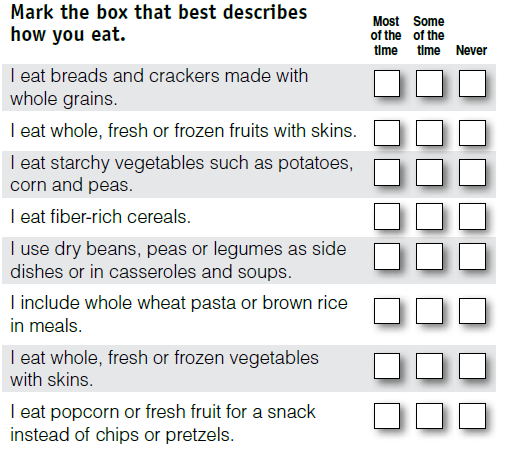Harvest Health at Home: Rate Your Fiber Fitness (FN1458, Reviewed Nov. 2019)
Availability: Web only

How Did You Do?
Add the number of boxes you checked in each column.
If you marked five or more answers “Most of the time,” you have a bumper crop! You are making smart fiber choices. Keep up the good work and keep reading to get some new ideas.
If you marked most of your answers “Some of the time,” your harvest is near. You are on your way to fiber fitness. Read more to learn about ways to add fiber to your diet.
If you marked most of your answers “Never,” then your crop rained out. If you checked most answers in the last column, you need to eat more foods higher in fiber. Read more to find out how to become fiber-fit!
Fiber News
Fiber isn’t a “miracle food,” but adding fiber-rich foods to your diet can have health benefits. The National Cancer Institute suggests that foods high in fiber may be protective against some cancers, particularly colon cancer. Although the National Cancer Institute recommends getting 20 to 35 grams of fiber per day, Americans, on the average, are eating only about 10 to 15 grams of fiber per day.
Soluble fiber (found in oats, dry edible beans, barley and fruits) helps lower blood cholesterol and may reduce the risk of heart disease. Insoluble fiber (found in wheat bran, whole-wheat products and vegetables) helps prevent ulcers, constipation, hemorrhoids and diverticulosis. High-fiber foods usually are low in calories and many are inexpensive, too.
Easy and Delicious
These are some simple steps to increase fiber, but remember to increase your fiber intake slowly, and drink plenty of water to avoid digestive upset.
1 Choose whole-grain and bran breads. Look for “whole grain” (followed by wheat, oats, etc.) as the first listed ingredient.)
2 Choose fiber-rich breakfast cereals. The food label can state that a product is “a good source” of fiber if the food has 2.5 grams of fiber per serving. The package can claim “high in,” “rich in” or “excellent source of” fiber if the food provides 5 grams per serving.
3 Serve whole fruits and vegetables at every meal, and eat the skins whenever possible.
4 Experiment with dry edible beans, peas and lentils.
5 Snack on popcorn; dried fruits, such as figs, raisins and prunes; and whole-grain crackers. Be careful, though: dried fruits are high in calories. ¼ cup is considered one serving.
A Recipe to Try
Oat Bran Banana Bread
1 c. flour
1 tsp. baking soda
1¼ c. oat bran
¼ tsp. salt (optional)
1/3 c. brown sugar
¼ c. vegetable oil
2 eggs
½ c. skim milk
½ tsp. vanilla
1¼ c. banana, mashed
Stir together flour, soda, oat bran and salt. Set aside. In a mixing bowl, mix sugar and oil. Add eggs, milk and vanilla, beat until smooth. Mix in mashed banana. Add dry ingredients to banana mixture. Pour into loaf pan that has been sprayed with nonstick cooking spray or lightly greased. Bake at 350 F for 50 to 55 minutes. Cool 10 minutes in pan. Remove and cool. Makes one loaf.
Nutrition information per one-sixteenth slice serving: 121 calories, 2.3 grams fiber, 4.8 grams fat
Materials were partially funded by the USDA’s Supplemental Nutrition Assistance Program.
Source: Content adapted from “Harvest Health at Home: Eating for the Second 50 Years,”
North Dakota State University Extension Service; authored by Karen Heller, Susan J. Crockett and Joyce Merkel.
Reviewed November 2019

